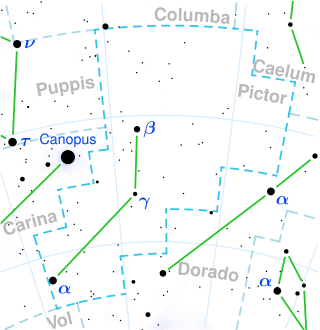Top Qs
Timeline
Chat
Perspective
Alpha Pictoris
Brightest star in the southern constellation of Pictor From Wikipedia, the free encyclopedia
Remove ads
Alpha Pictoris (α Pic, α Pictoris) is the brightest star in the southern constellation of Pictor. It has an apparent visual magnitude of 3.27,[2] which is bright enough to be viewed from urban areas in the southern hemisphere. This is actually a binary star system, whose components complete an orbit every three years and seven months.[6] It is close enough for its distance to be measured using parallax shifts, which yields a value of roughly 97 light-years (30 parsecs) from the Sun, with a 5% margin of error.[1] Alpha Pictoris has the distinction of being the south pole star of the planet Mercury.[14]
Remove ads
Properties
Summarize
Perspective
With an estimated age of 660 million years,[11][12] the primary component is a relatively young Lambda Boötis star.[15] The stellar classification of A8 Vn kA6[3] shows this peculiarity, with the kA6 notation indicating weaker than normal calcium K-lines in the spectrum. The 'n' following the main sequence luminosity class of V indicates the absorption lines in the spectrum are broad and nebulous. This is caused by the rapid spin of the star, which has a high projected rotational velocity of 206 km/s.[10] Spectroscopy shows narrow, time-varying absorption features being caused by circumstellar gas moving toward the star. This is not the result of interstellar matter, but a shell of gas along the orbital plane. Alpha Pictoris is categorized as a rapidly rotating shell star that may have recently ejected mass from its outer atmosphere.[9][16]
Alpha Pictoris A is larger than the Sun, with a 60% greater mass[6] and a 355% greater radius.[7] It is radiating 40 times as much luminosity as the Sun from its outer atmosphere at an effective temperature of 7,550 K.[8] At this heat, the star glows with the white hue of an A-type star.[17] It is also one of the brightest known Delta Scuti variables.[18] The space velocity components of this star in the galactic coordinate system are U = -22, V = -20 and W = -9 km/s.[19]
Data from the Hipparcos mission uncovered the presence of a binary companion[15] with a companion orbiting at a semimajor axis of around 3.25 AU, or three times the distance from Earth to the Sun.[6][a] Alpha Pictoris is an X-ray source, which is unusual for an A-type star since stellar models don't predict them to have magnetic dynamos. This emission may instead be originating from the companion.[9][20]
Remove ads
Notes
- Calculated using a3 = (M1 + M2) • P2,
where a is the semi-major axis in astronomical units, M1 and M2 are the primary and secondary's mass respectively, in M☉, and P is the period in years.
References
Wikiwand - on
Seamless Wikipedia browsing. On steroids.
Remove ads

